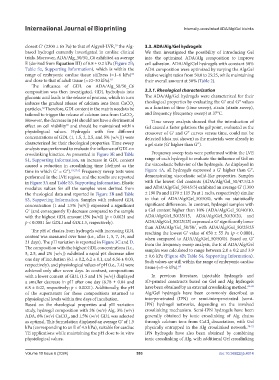Page 561 - IJB-10-6
P. 561
International Journal of Bioprinting Internally-crosslinked ADA/Alg/Gel bioinks
closest G′ (2300 ± 65 Pa) to that of Algysil-LVR, the Alg- 3.3. ADA/Alg/Gel hydrogels
59
based hydrogel currently investigated in cardiac clinical We then investigated the possibility of introducing Gel
trials. Moreover, ADA/Alg_50/50_C6 exhibited an average into the optimized ADA/Alg composition to improve
E (derived from Equation III) of 6.8 ± 0.2 kPa (Figure 2B; cell adhesion. ADA/Alg/Gel hydrogels with constant 50%
Table S2, Supporting Information), which is within the ADA composition were optimized by varying the Alg:Gel
range of embryonic cardiac tissue stiffness (≈1–6 kPa) relative weight ratios from 50:0 to 25:25, while maintaining
60
and close to that of adult tissue (≈10–30 kPa). 61 their overall amount at 50% (Table 2).
The influence of GDL on ADA/Alg_50/50_C6
composition was then investigated. GDL hydrolysis into 3.3.1. Rheological characterization
gluconic acid leads to the release of protons, which in turn The ADA/Alg/Gel hydrogels were characterized for their
induces the gradual release of calcium ions from CaCO 3 rheological properties by evaluating the G′ and G″ values
62
particles. Therefore, GDL content in the matrix needs to be as a function of time (time sweep), strain (strain sweep),
tailored to trigger the release of calcium ions from CaCO . and frequency (frequency sweep) at 37°C.
3
However, the decrease in pH should not have a detrimental Time sweep analysis showed that the introduction of
effect on cell viability and should be maintained within Gel caused a faster gelation: the gel point, evaluated as the
63
physiological values. Hydrogels with five different crossover of G′ and G″ curves versus time, could not be
concentrations of GDL (1, 1.5, 2, 2.5, and 5% [w/v])) were detected (data not shown) as the materials were already in
characterized for their rheological properties. Time sweep a gel state (G′ higher than G″).
analysis was performed to evaluate the influence of GDL on
crosslinking kinetics. As presented in Figure 3E and Table Frequency sweep tests were performed within the LVE
S1, Supporting Information, an increase in GDL content range of each hydrogel to evaluate the influence of Gel on
caused a reduction in crosslinking time (defined as the the viscoelastic behavior of the hydrogels. As displayed in
time in which G′ = G″). 18,27,62 Frequency sweep tests were Figure 4A, all hydrogels expressed a G′ higher than G″,
performed in the LVE region, and the results are reported demonstrating viscoelastic solid-like properties. Samples
in Figure 3A and Table S3, Supporting Information. Elastic with the lowest Gel contents (ADA/Alg/Gel_50/47.5/2.5
modulus values for all the samples were derived from and ADA/Alg/Gel_50/45/5) exhibited an average G′ (1300
the rheological data and reported in Figure 3B and Table ± 190 Pa and 1170 ± 115 Pa at 1 rad/s, respectively) similar
S3, Supporting Information. Samples with reduced GDL to that of ADA/Alg/Gel_50/50/0, with no statistically
concentration (1 and 1.5% [w/v]) expressed a significant significant differences. In contrast, hydrogel samples with
G′ (and consequently E) decrease compared to the sample a Gel content higher than 10% (ADA/Alg/Gel_50/40/10,
with the highest GDL amount (5% [w/v]) (p < 0.0021 and ADA/Alg/Gel_50/35/15, ADA/Alg/Gel_50/30/20, and
p < 0.0001 for GDL1 and GDL1.5, respectively). ADA/Alg/Gel_50/25/25) expressed a G′ significantly lower
than ADA/Alg/Gel_50/50/, with ADA/Alg/Gel_50/25/25
The pH of eluates from hydrogels with increasing GDL reaching the lowest G′ value of 650 ± 55 Pa (p < 0.0001,
content was measured over time (i.e., after 1, 5, 7, 14, and when compared to ADA/Alg/Gel_50/50/0). Based on G′
21 days). The pH variation is reported in Figure 3C and D. from the frequency sweep analysis, the E of ADA/Alg/Gel
The composition with the highest GDL concentrations (i.e., samples was calculated to range between 2.0 ± 0.2 and 3.9
5, 2.5, and 2% [w/v]) exhibited a rapid pH decrease after ± 0.6 kPa (Figure 4B; Table S4, Supporting Information).
one day of incubation (6.1 ± 0.2, 6.2 ± 0.1, and 6.56 ± 0.03, Such values are still within the range of embryonic cardiac
respectively), and physiological values of pH (i.e., 7.4) were tissue (≈1–6 kPa). 60
achieved only after seven days. In contrast, compositions
with a lower content of GDL (1.5 and 1% [w/v]) displayed In previous literature, injectable hydrogels and
a smaller decrease in pH after one day (6.78 ± 0.04 and 3D-printed constructs based on Gel and Alg hydrogels
6.8 ± 0.02, respectively; p < 0.0001). Additionally, the pH have been obtained by an external crosslinking method. 64-69
of the supernatant for these compositions returned to Alg/Gel hydrogels have been commonly described as
physiological levels within five days of incubation. interpenetrated (IPN) or semi-interpenetrated (semi-
Based on the rheological properties and pH variation IPN) hydrogel networks, depending on the involved
study, hydrogel composition with 3% (w/v) Alg, 3% (w/v) crosslinking mechanism. Semi-IPN hydrogels have been
ADA, 6% (w/v) CaCO , and 1.5% (w/v) GDL was selected generally obtained by ionic crosslinking of Alg chains
3
as optimal. This formulation displayed an average G′ of 1.5 through calcium ions from CaCl dissociation, with Gel
2
kPa (corresponding to an E of 4.5 kPa), suitable for cardiac physically entrapped in the Alg crosslinked network. 70-72
TE applications while maintaining the pH close to in vitro IPN hydrogels have also been obtained by combining
physiological values. ionic crosslinking of Alg, with additional Gel crosslinking
Volume 10 Issue 6 (2024) 553 doi: 10.36922/ijb.4014

